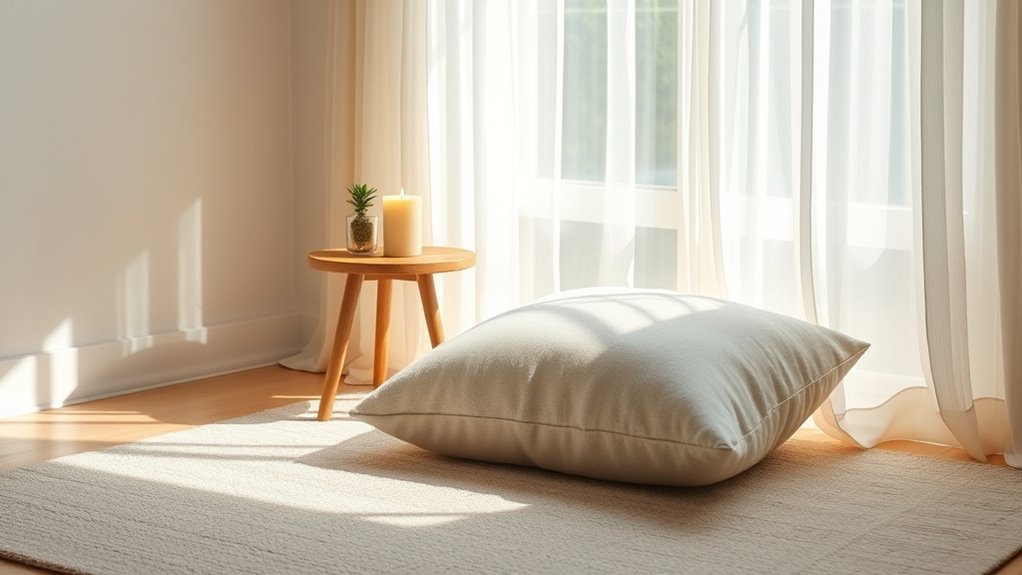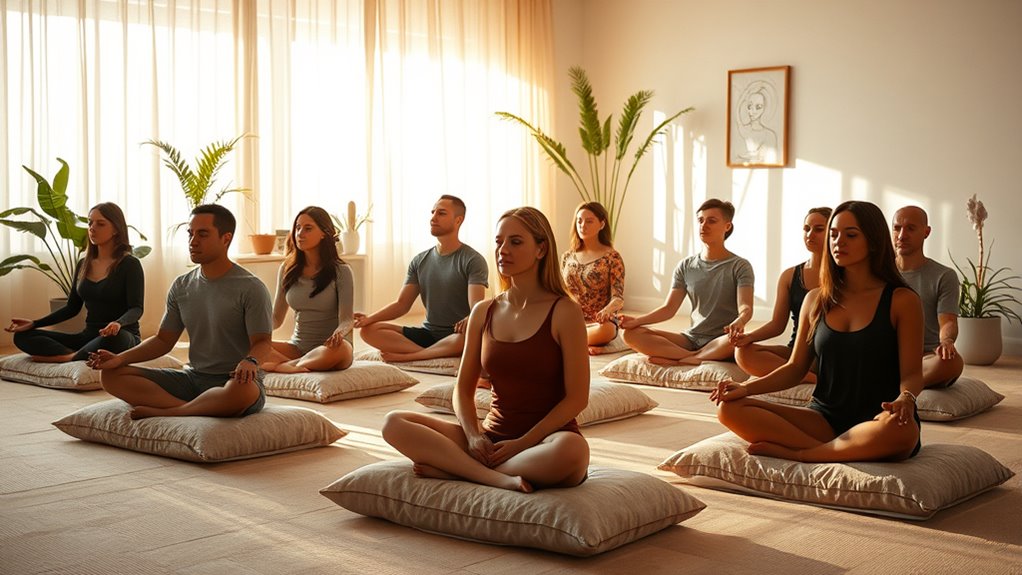To practice mindfulness in daily life, focus on simple techniques like mindful breathing—pay attention to your breath without trying to control it—and do body scans to release tension. Engage fully in routine activities like eating, walking, or chores by noticing sensations and surroundings. Set reminders to pause periodically, and create a calm environment with minimal clutter. If you keep exploring, you’ll discover more ways to seamlessly integrate mindfulness into your everyday routine.
Key Takeaways
- Incorporate mindful breathing by focusing on each inhale and exhale without trying to control it.
- Engage fully in routine activities, paying attention to sensations, sounds, and sights during daily tasks.
- Practice body scans regularly to enhance body awareness and release tension.
- Use reminders like alarms or sticky notes to prompt brief mindfulness pauses throughout the day.
- Create a calming environment with minimal clutter, soft lighting, and natural textures to support focused practice.
Incorporate Mindful Breathing Into Your Day

Incorporating mindful breathing into your daily routine is a simple yet powerful way to reduce stress and improve focus. You can do this sitting, standing, or lying down—wherever you are. Start by focusing on your inhale and exhale, noticing each breath without trying to change it.
If you’re feeling stressed, take exaggerated breaths: inhale deeply, hold briefly, then exhale slowly. Maintain good posture, with elbows back to allow chest expansion, which encourages better breathing. Use sensations, like the feeling of air through your nostrils or chest rising, to stay present. Proper breathing techniques can enhance the calming effects of mindful breathing and support overall well-being. Recognizing AI safety concerns related to mental health apps emphasizes the importance of mindful practices in managing digital stressors. Practicing progressive relaxation techniques can further deepen your sense of calm and physical awareness.
Engaging in mindful breathing can also promote emotional regulation, helping you manage your reactions and foster a sense of inner calm. Incorporating these techniques during routine activities like commuting or chores can make mindfulness a seamless part of your day. Regular practice helps make mindful breathing a natural, effective tool for emotional balance.
Engage in Body Scans to Release Tension

Engaging in body scans can be a highly effective way to release tension and cultivate mindfulness throughout your day. Find a quiet, comfortable space and take a few deep breaths to center yourself.
Begin by slowly paying attention to different parts of your body, starting at your feet or head, noticing sensations without judgment. As you move through each area, visualize tension leaving your body with each exhale. Incorporating body awareness techniques can deepen your practice and enhance your ability to stay present in the moment. Additionally, focusing on mindfulness in daily routines can help you integrate these practices seamlessly into everyday activities. Practicing these techniques regularly can also help improve your overall mindfulness practice and mental clarity. Focusing on indoor air quality during your routine can create a more calming environment and support your well-being. Focus on feelings of relaxation and release, acknowledging any areas of tightness or discomfort without resistance. Regularly practicing body scans builds greater body awareness and strengthens your mind-body connection. Incorporating techniques like mindfulness-based approaches can further enhance your practice and overall well-being.
Practice Mindfulness During Routine Activities

Practicing mindfulness isn’t limited to formal exercises; it can be seamlessly integrated into your daily routines. As you go about routine activities, bring your full attention to each moment. When walking, focus on the sensation of your feet touching the ground and each step you take. During chores, notice the textures, sounds, and smells involved—like the feel of soap or the scent of cleaning products. While grooming, be present with each movement, feeling the brush or water. Even during desk work or driving, observe your thoughts without judgment and stay attentive to your body and environment. Incorporating dream symbolism techniques during daily activities can deepen your sense of presence and emotional well-being. Paying attention to your body and environment can help you notice subtle physical sensations and emotional cues that often go unnoticed in daily life.
Use Focused Attention During Meals and Hydration

Focusing your full attention on meals and hydration transforms everyday acts into powerful mindfulness practices. When you eat, engage all your senses—notice flavors, textures, smells, and colors. Slow down, taking your time with each bite, which aids digestion and helps your brain recognize fullness. Avoid distractions like screens to fully enjoy your food and company. Incorporating mindfulness practices into mealtimes can further enhance your awareness and presence. Pay attention to hunger and fullness cues to prevent overeating and foster healthier habits. During hydration, start your day with water to energize and support digestion. Set hydration goals and monitor your body’s signals of thirst. Incorporate water into routines, like drinking before meals, and reflect on how hydration influences your mood and health. These focused moments deepen awareness, making daily routines more intentional and nourishing. Additionally, practicing focused attention during these acts can significantly improve your overall well-being and mental clarity. Engaging in mindful hydration also contributes to emotional regulation by helping you become more aware of physical sensations and feelings throughout the day. Recognizing the significance of dream symbols can help you better understand your subconscious messages and emotional states. Regularly practicing these mindful habits can also positively impact your gym attendance, encouraging consistency in your fitness routine.
Cultivate Awareness While Walking or Moving

When you walk or move intentionally, you can cultivate a deeper awareness of your body and surroundings by paying close attention to each step. Focus on sensations in your feet, ankles, calves, knees, hips, hands, arms, torso, neck, and shoulders. Break down each step into components: lifting, moving, placing, and shifting weight. Notice how your weight transfers from one foot to the other, helping you stay balanced. Maintain good posture and observe your breath patterns to deepen the experience. Engage your senses by listening to sounds, observing sights, and smelling the environment around you. Slowing down your pace allows for greater awareness, and by mindful *progressions* between body parts, you stay present with each movement. Incorporating mindset principles from the Law of Attraction can enhance your focus and positivity during this practice. Understanding the importance of contrast ratio in visual clarity can help you appreciate the subtle details in your environment, enriching your sensory experience. Being mindful of essential oils for relaxation and focus can further deepen your awareness and calm your mind during movement. Using halal-certified products, such as natural oils, ensures your practice aligns with your values. This practice enhances mood, reduces stress, and promotes physical well-being.
Establish a Quiet Space for Regular Meditation

Creating a dedicated, quiet space for meditation can greatly support your regular practice. Choose a consistent location that feels peaceful and free from distractions.
Guarantee the environment is well-ventilated to keep you comfortable and alert. Keep the space minimal and clutter-free to reduce visual distractions and promote mental clarity.
Use comfortable seating, like a cushion or straight-backed chair, to support good posture. Incorporate calming colors, such as blue or green, and soft lighting to foster relaxation.
Adding natural textures like wood or bamboo can create warmth. Consider including gentle sounds, like rain or ocean waves, or a physical object like a candle to serve as an attention anchor.
This dedicated space helps establish a routine, making meditation easier and more effective.
Set Reminders for Mindful Breaks Throughout the Day

Setting reminders throughout the day guarantees you don’t forget to pause and practice mindfulness. Use mindfulness apps like Calm or Headspace to alert you for short exercises. Sticky notes placed in visible spots serve as quick prompts to take a break. Phone alarms set at regular intervals remind you to pause, breathe, and reset.
Scheduling dedicated mindful sessions in your digital calendar helps build consistency. If you’re in a workplace, share reminders with colleagues to foster a mindful environment. These cues ensure you carve out moments for relaxation, reducing stress and sharpening focus.
Consistent reminders make mindfulness a natural part of your routine, helping you stay calm, centered, and more aware throughout your busy day.
Participate in Mindfulness Workshops or Group Practices

Participating in mindfulness workshops or group practices transforms individual efforts into shared experiences that can deepen your understanding and commitment. These settings foster personal growth while creating a sense of belonging, helping you manage mental health challenges like anxiety and depression by keeping you focused on the present moment.
Group activities encourage you to exchange experiences, receive support, and learn from others facing similar struggles. Tailored workshops address specific needs, such as workplace stress, promoting emotional resilience and teamwork.
The group environment also reduces distractions, allowing for a more profound mindfulness experience. Most importantly, participating voluntarily and respecting individual autonomy guarantees you feel safe, motivated, and empowered in your practice—boosting your emotional and mental resilience over time.
Maintain Consistency to Deepen Your Mindfulness Practice

Maintaining consistency is essential for deepening your mindfulness practice, as regular effort helps reinforce the neural pathways that support present-moment awareness.
You can integrate mindfulness into daily habits, like right after waking or before bed, or set reminders to practice briefly throughout the day.
Start small with sessions of 5-10 minutes, gradually increasing as you become more comfortable.
Incorporate techniques like mindful breathing, body scans, or mindful walking to strengthen awareness.
Setting daily intentions and reflecting on your progress keeps you motivated, while celebrating small wins boosts confidence.
Use tools like mindfulness apps, books, or online courses for guidance.
Overcoming distractions and connecting with community support further sustains your practice, making mindfulness a lasting part of your life.
Frequently Asked Questions
How Can I Stay Motivated to Practice Mindfulness Daily?
You want to stay motivated to practice mindfulness daily, and the key is consistency. Set clear goals and create a routine, like morning mindfulness or evening reflection, to build habits.
Use reminders, mindfulness apps, or an accountability partner to stay on track. Track your progress in a journal, celebrate small wins, and join a mindfulness group for support.
These strategies help keep your motivation high and make mindfulness a lasting part of your life.
What if I Find It Hard to Focus During Mindfulness Exercises?
If you find it hard to focus during mindfulness exercises, don’t get discouraged. You can gently label distractions without engaging with them and then redirect your attention back to your breath or body scan.
Remember, it’s normal for your mind to wander. Practice patience and consistency, and over time, you’ll notice your ability to stay present improves.
Find a quiet space and be kind to yourself during the process.
Can Mindfulness Help With Managing Specific Mental Health Issues?
Mindfulness can markedly help you manage specific mental health issues like depression and anxiety. By practicing regularly, you improve emotional regulation, reduce stress, and build resilience.
It helps you stay present, which decreases negative thoughts and feelings. With consistent effort, mindfulness can lower symptoms, boost mood, and increase mental clarity.
Over time, you’ll notice better coping skills and a more balanced outlook, making it a valuable tool for mental health management.
How Do I Choose the Right Mindfulness App for Beginners?
When choosing a mindfulness app for beginners, you should consider whether it offers free content to start without commitment, like Insight Timer.
Look for apps with a variety of guided meditations and a user-friendly interface, such as Headspace.
Also, check if it provides community support, progress tracking, and compatibility with your devices.
Picking an app that fits your needs and feels accessible makes beginning your mindfulness journey easier and more engaging.
What Are Common Mistakes to Avoid in Mindfulness Practice?
Think of mindfulness practice as planting seeds—you need to nurture them carefully. To avoid common mistakes, stay consistent and set up a calm environment.
Don’t expect immediate results or try too hard; that only creates tension. Be patient and flexible, integrating mindfulness into daily activities like walking or eating.
Conclusion
So, there you have it—your foolproof guide to turning daily life into a zen playground. Who knew that breathing, body scans, and mindful munching could make you a calmer, more enlightened human? Just remember, consistency is key—unless you enjoy chaos and stress. So go ahead, sprinkle some mindfulness into your busy schedule, and watch your worries vanish faster than your last diet resolution. Namaste, or whatever sounds cool these days.









